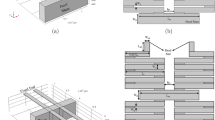Abstract
Piezostack-based active mounts have shown great efficiency for vibration control in a wide frequency range. In this paper, we investigate the performances of the global semi-active control strategy presented by Ichchou et al. [1] for a control system consisting of an active mount and a supported mass. The control strategy allows extracting vibrations energy of the supported mass, storing it in accumulators to be reused for powering in part the actuators (two piezostacks). Consequently, energy needs are reduced versus good control performances comparable to those of the active control based on the negative velocity feedback. The performances of the controller are evaluated in both frequency (transmitted force) and time (acceleration) domains which show that vibrations of the supported mass due to base excitations are efficiently attenuated with the proposed law. An energetic analysis confirms the reduced energy requirement compared to the active scheme.
Similar content being viewed by others
References
Ichchou M N, Loukil T, Bareille O, Chamberland G, Qiu J. A reduced energy supply strategy in active vibration control. Smart Materials and Structures, 2011, 20(12): 125008
Kamada T, Fujita T, Hatayama T, Arikabe T, Murai N, Aizawa S, Tohyama K. Active vibration control of frame structures with smart structures using piezoelectric actuators (Vibration control by control of bending moments of columns). Smart Materials and Structures, 1997, 6(4): 448–456
Kim S, Choi S, Hong S, Han M. Vibration control of flexible structure using a hybrid mount. International Journal of Mechanical Sciences, 2004, 46(1): 143–157
Ichchou M N, Jemai B, Bellon L, Jezequel L. Active rubber mounts by means of piezoelectric actuators, experimental work. Smart Materials and Structures, 2001, 10(5): 1095–1099
Huang X, Elliott S, Brennan M. Active isolation of a flexible structure from base vibration. Journal of Sound and Vibration, 2003, 263(2): 357–376
Howard C. Active isolation of machinery vibration from flexible structures. Dissertation for the Doctoral Degree. South Australia: The University of Adelaide
Benassi L, Elliott S. Global control of a vibrating plate using a feedback controlled inertial actuator. Journal of Sound and Vibration, 2005, 283(1–2): 69–90
Benassi L, Elliott S, Gardonio P. Active vibration isolation using an inertial actuator with local force feedback control. Journal of Sound and Vibration, 2004, 276(1–2): 157–179
Nguyen V, Choi S, Han Y, Choi S, Moon S. The design of a piezostack-based active mount and application to a vibration control system. Smart Materials and Structures, 2008, 17(6): 065029
Nguyen V, Choi S. A robust vibration control of a multi-active mount system subjected to broadband excitation. Smart Materials and Structures, 2011, 20(5): 055002
Lee Y, Lee C. Dynamic analysis and control of an active engine mount system. Proceedings of the Institution of Mechanical Engineers Part D, Journal of Automobile Engineering, 2002, 216(11): 921–931
Jalili N, Iv D W K. Structural vibration control using an active resonator absorber: modeling and control implementation. Smart Materials and Structures, 2004, 13(5): 998–1005
Mitsuhashi K, Biwa T, Mizuhara S. Application of active vibration isolating system to diesel engine mounting. CIMAC Proceeding of the 18th International Congress on Combustion Engines, 1989, 1: 281
Nguyen V Q, Choi S M, Choi S B, Moon S J. Sliding mode control of vibration system using a hybrid active mount. Journal of Mechanical Engineering Science, 2009, 223(6): 1327–1337
Ushijima T, Kumakawa S. Active engine mount with piezo-actuator for vibration control. Society of Automotive Engineers, 1993, 930201
Chung J H, Kim B H, Kwak J S, Jeong J A, Lee H Y. An experimental study on the characteristics of rubber mounts for naval shipbord application. Proceedings of the Annual Spring Meeting SNAK, 2004, 402–409
Yu Y, Naganathan N G, Dukkipati R V. A literature review of automotive vehicle engine mounting systems. Mechanism and Machine Theory, 2001, 36(1): 123–142
Hong S R, Choi S B, Jung W J, Ham I B, Kim D K. Vibration control of an er mount subjected to high static loads. Journal of Sound and Vibration, 2001, 242(4): 740–748
Choi S H, Choi Y T, Choi S B, Cheong C C. Performance analysis of an engine mount featuring fluids and piezoactuators. International Journal of Modern Physics B, 1996, 10(23–24): 3143–3157
Hong S, Choi S. Vibration control of a structural system using magneto-rheological fluid mount. Journal of Intelligent Material Systems and Structures, 2005, 16(11–12): 931–936
Choi S B, Hong S R, Sung K G, Sohn J W. Optimal control of structural vibrations using a mixed-mode magneto-rheological fluid mount. International Journal of Mechanical Sciences, 2008, 50(3): 559–568
Loukil T, Bareille O, Ichchou M, Haddar M. Elective vibration control of multi-model structures with lower power requirement. Smart Materials and Structures (submitted)
Metz D. Military specification 17508f(sh). Naval Sea Systems Command Department of the Navy
Military standard mil-std-167-1a. Naval Sea Systems Command Department of the Navy
Choi S, Cheong C, Kim S. Control of flexible structures by distributed piezofilm actuators and sensors. Journal of Intelligent Material Systems and Structures, 1995, 6(3): 430–435
Brennan M, McGowan A. Piezoelectric power requirements for active vibration control. In: SPIE Proceedings Series, Vol. 3039. Society of Photo-Optical Instrumentation Engineers, 1997, 660–669
Shu Y C, Lien I C. Analysis of power output for piezoelectric energy harvesting systems. Smart Materials and Structures, 2006, 15(6): 1499–1512
Author information
Authors and Affiliations
Corresponding author
Rights and permissions
About this article
Cite this article
Loukil, T., Bareille, O., Ichchou, M.N. et al. A low power consumption control scheme: application to a piezostack-based active mount. Front. Mech. Eng. 8, 383–389 (2013). https://doi.org/10.1007/s11465-013-0274-6
Received:
Accepted:
Published:
Issue Date:
DOI: https://doi.org/10.1007/s11465-013-0274-6



